| |
|
St
Margaret, Tivetshall St Margaret The area between
Diss and Attleborough is intensely agricultural. It's
hard to imagine anyone buying a holiday cottage here, or
a weekend home. Of course, a couple of hundred years ago
this was a much busier place than it is today, and we
couldn't have wandered the lanes without seeing any other
people like we can nowadays. In those days, it took fifty
people on a farm to do the work that two or three can do
today, and villages like Tivetshall supported a great
range of trades and occupations.
Norfolk villages were fairly self-sufficient, and had to
be. The decline set in after the 1851 census, the
population falling as young people set off to find
prosperous new lives in the factories of Norwich and
Ipswich. Today, the old order has gone forever, and the
few farmers that remain struggle to make a living. The
nearest shops are in Diss, and cars rule the lanes. But
I'm still pleased that there aren't many of them.
Perhaps symbolically of this new world, Tivetshall lost
its other church, St Mary, to the sonic boom of a jet
plane in the late 1940s. But the one that remains is a
jewel. St Margaret sits out in the flat fields with only
a farm for company, but its small, crowded churchyard is
well-maintained, a blanket of emerald in this ploughed
empty landscape.
I came back here on one of those stiflingly hot days of
which the summer of 2018 had so many. It was a relief
after the straight miles from Gissing to get off my bike
and wheel it into the shrouded churchyard. You approach
the building from the east, and at first sight the
chancel is curious. Its steeply pitched roof is higher
than the western part of the church. Although it is
basically early 14th Century, despite the addition of
later windows, it looks rather like a farmworker's
cottage tacked to the east of the nave. The tower is
broadly contemporary, which, as Pevsner points out, is
also curious, for a major bequest for its rebuilding was
made in 1456. The nave is clinically perpendicular with
crisp windows, so perhaps they spent the money there
instead. Certainly, the south doorway appears late
medieval, and perhaps even later than the Reformation.
This was about my half-dozenth visit, I suppose, and yet
still with anticipation I stepped through the doorway
into the small church. You can see at once that it is a
remarkable place. On an earlier version of this account I
described this as a ramshackle, cluttered and untidy
church, delightfully so, and how much I admired it for
that. I hoped that no one in the parish would have been
offended by this, but in any case this church underwent a
major restoration in the first decade of the 21st
Century, and today feels crisp and loved, though still
intensely rural, and perhaps even more delightful. It
feels like a church of the common people.
The stone floors and old woodwork of the nave set the
tone, but what most people come to Tivetshall St Margaret
to see is to the east of them. In early days, churches
were essentially two separate rooms separated by a screen
under a boarded tympanum. This is hard to imagine today,
unless you come to somewhere like Tivetshall St Margaret,
because here the chancel arch still retains its tympanum.
It is safe to say that almost all medieval churches once
had one of these, but they were mostly removed at the
Reformation because they displayed the rood, a depiction
of the crucifixion which was proscribed by the Anglican
reformers. In a few places in Norfolk, however, these
tympanum boards have survived, and as at nearby
Kenninghall and at Ludham, the tympanum here was painted
over in the second half of the 16th Century with the
state Royal Arms. This had been a decree of Henry VIII,
but no Henry VIII royal arms survive. So, the set for
Elizabeth I at Tivetshall St Margaret is one of the
earliest in England.
The boards stretch across the church, wall to wall and
from the top of the roodscreen to the roof. The lion and
the dragon flank the vast Arms, with God Save Our
Quene Elizabeth painted beneath, and a neat reminder
of who was now in charge: Let every sowle submit hym
selfe unto the authority of the hyer powers, for there is
no power but of God, the powers that be are ordayned by
God. The design includes the symbols of the other
four Tudor monarchs, as well as the badge of Elizabeth's
mother, Anne Boleyn.
Beneath
them, the Ten Commandments are rendered as a chunk of
scriptural prose. There is certainly no finer set in
England of this period. When I first saw this set about
twenty years ago it was covered in dark varnish, but this
was removed as part of the recent sensitive restoration,
and they are now as vibrant and clear as when they were
painted. We even know which churchwardens were
responsible for their construction and placement, for the
date is given as 1587, and at the sides of the tympanum
they are remembered: Rychard Russell, Jaffrey Neve
and John Freman: In there tyme they caused this for to be
done.
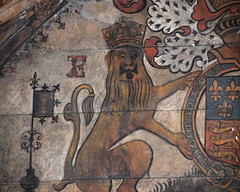 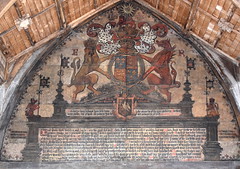 
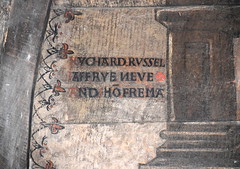 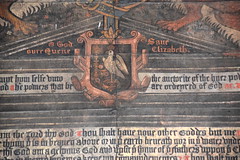 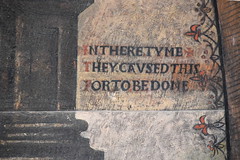
The screen
below is painted in red and green, with gold stencilling
and a shield depicting four magpies. Beyond, the chancel
fills with light, and a gorgeous red, green and gold
English altar, echoing the rood dado panels, is
surrounded by a Sarum screen. To the north of it is an
Easter Sepulchre that dates from the original building of
the chancel.
The church retains its medieval bench ends, which the
Victorians would surely have itched to replace, they are
in such rough condition. Perhaps this place was simply
too poor and too remote for anyone important to notice.
They are badly damaged, in most cases just the lower half
of each figure surviving. One has a small dragon cowering
at the base, and has been recorded as St George, but I
think the figure above has wings, and is probably St
Michael. Perhaps the others are Saints too, and yet one
figure has at its feet something that looks like nothing
so much as a plough. Looking closely at the others,
another figure appears to be standing among cornstalks,
while yet anouther appears to be holding a harness. They
could perhaps be Labours of the Months, and the
remarkable thought dawns that these could have been
depictions of 15th Century locals. Whatever, they must
have been wonderful in their day. There are some earthy
17th Century additions, presumably the work of a local
carpenter.
A small church, but one to spend time in. Here is the
past hanging on, a touchstone with its thread of
continuity, but also a glimpse of Norfolk just out of
sight, no electricity, no running water, no sound at all
except the birdsong from the tree-bowered churchyard
outside. Not much has happened here in the last century
or so.
I am used to coming across accounts I have written about
churches pinned up on their noticeboard, and there is one
here, but also something I had not seen before, a quote
of mine presented in isolation, as a kind of
inspirational poster if you like, which pleased me no
end. I had actually written it about another church,
Hunworth, away to the north, but it stands as well for
Tivetshall St Margaret, and so I repeat it here:
a quiet, ancient space,
prayerful and numinous,
open and welcoming,
a place to stop and step out of time
into eternity, if only for a moment.
This is a super church, full of atmosphere and with an
intense sense of its rural past. A little treasure, a
Norfolk delight.
Simon Knott, August 2018
|
|
|
